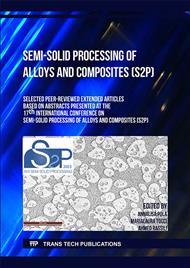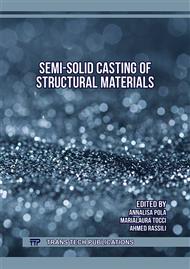p.115
p.121
p.127
p.135
p.141
p.147
p.157
p.165
p.171
Numerical Simulations of the Squeeze Flow of Thixotropic Semisolid Slurries
Abstract:
We propose a methodology for the rheological characterization of semisolid metal slurries using experimental squeeze flow data. The material is modelled as a structural thixotropic viscoplastic material, obeying the regularized Herschel-Bulkley constitutive equation. The yield stress and the power-law exponent are assumed to vary with the structural parameter that is governed by a first-order kinetics. The squeeze flow is simulated using finite elements in a Lagrangian framework. The evolution of the sample height has been studied for all the ranges of the Bingham and Reynolds numbers, the power-law exponent as well as the kinetics parameters of the structural parameter. Systematic comparisons have been carried out with experimental data on a semisolid aluminium alloy (A356) sample, compressed from its topside at a temperature of 582 °C under a specified load, which eventually becomes constant. Excellent agreement with the experimental data could be achieved provided that at the initial instances (up to 0.01s) of the experiment the applied load is much higher than the nominal experimental load and that the yield stress and the power-law exponent vary linearly with the structural parameter. The first requirement implies that a different model should be employed during the initial stages of the experiment. As for the second one, the evolution of the sample height can be reproduced allowing the yield stress to vary from 0 (no structure) to a maximum nominal value (full structure) and the power-law exponent from 0.2 to 1.4.
Info:
Periodical:
Pages:
141-146
Citation:
Online since:
August 2023
Price:
Сopyright:
© 2023 Trans Tech Publications Ltd. All Rights Reserved
Share:
Citation:



